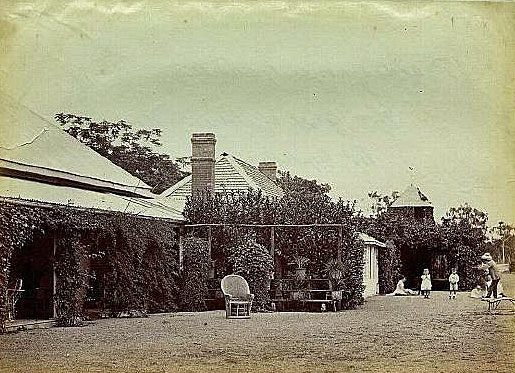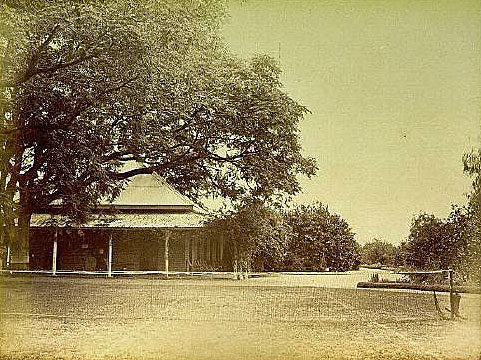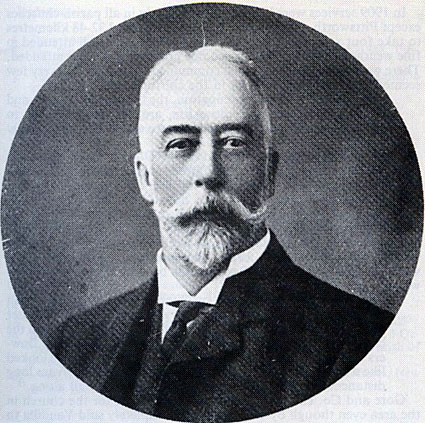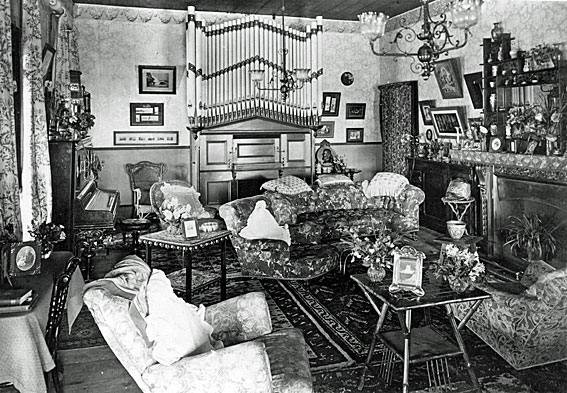
Yandilla Homestead
[Photograph from the Hume Family Collection,
Fryer Library, University of Queensland]

Yandilla Homestead
[Photograph from the Hume Family Collection,
Fryer Library, University of Queensland]
Historical and Technical Documentation by Geoffrey Cox1
© OHTA 2008, 2017 (last updated May 2017)
Situated on the Gore Highway between Toowoomba and Goondiwindi, the district of Yandilla (near Millmerran) is named after the property by that name established near the Condamine River by the Gore family of Ireland, most of whom had settled in the area after sailing from England in 1841.2 The existence of two pipe organs at Yandilla - the first in All Saints' Church, and the second in the Yandilla homestead - has been brought to light following the publication in 1987 of Grant Uebergang's booklet commemorating the centenary of the dedication of All Saints' Church.3 Mr Uebergang has generously assisted in supplying other source material that is acknowledged in the footnotes following.
The first of the two Yandilla organs was built by Revd William Francis Gore (1819-1885) and installed in All Saints' Church, Yandilla, after his death. It is now located at St John's Anglican Church, Bulimba. The second organ, which was located in the drawing room of the Yandilla homestead, was built there by Mr Gerard R. Gore (1855-1912).4
The original wooden homestead at Yandilla no longer exists, but it is known to have been extended in the 1850s with a commodious brick addition, with spacious high-ceilinged rooms.5

Yandilla Homestead, 1884
[Photograph from Hume Family Collection,
Fryer Library, University of Queensland]
Gerard Ralph Gore, the fourth son of The Revd W.F. Gore, was born in 1855 at Parramatta, NSW, during the time his father was Rector at All Saints' Church there. The family returned to live in England in 1862, and Gerard was educated at Marlborough College and at Heidelburgh University in Germany. He entered the academy at Woolwich, intending to go into the Royal Engineers or the Royal Artillery, but was persuaded instead to join his elder brother, Francis Arthur Gore, at Yandilla. He married in 1882, and took over the management of the Yandilla property after the death of his brother in 1904.6

Gerard Ralph Gore (1855-1912)
[Photograph reproduced in G. Uebergang,
A History of All Saints Anglican Church,
Yandilla, Queensland (1987)]
The organ built by Gerard Gore for the drawing room at Yandilla was distinctive in that the keys were made of cedar from cigar boxes, and the pipes from cartridge paper.7 It was reported that he had made 'every part himself,' and that it was 'nearly completed' in November 1897.8 Like a similar instrument made by Mr H.E. Fisher of Brisbane around 1895-1900, it appears therefore to have been inspired by Mark Wicks' book, Organ building for Amateurs: A Practical Guide for Home-Workers (London & New York: Ward, Lock, 1887).9

The Drawing Room at Yandilla Homestead, c.1910
[The Pastoral Homes of Australia: New South Wales and Queensland
(Melbourne: Pastoralists' Review, 1911), p. 368]
Gerald Gore tuned and played the organ, and a visitor to Yandilla in late 1907 or early 1908 wrote of it as follows in the Visitor's Book:
I know a dear man named Gore
The cleverest wit I saw
An organ he mayde
Which Mrs G. playde
And so for the music Oh Lor".10
Gerard Gore died in Melbourne in 1912 on his way back to Queensland after a trip to England.11
Local historians at Yandilla record variously that the instrument was given by Gore's married daughter, Mrs Trude, to 'a church in Taringa,'12 or that it was presented by his wife, Christina Gore, specifically to the Anglican Church at Taringa.13 Either way, there is no doubt that the organ went to St Paul's Anglican Church, Taringa.
From here, the history of Gerard Gore's organ can be traced with reasonable certainty, and further details can be provided. Mr J.H. Whitehouse Jnr recalled that the organ at Taringa originally had cardboard pipes, which were replaced by metal pipe at an unspecifed date (apparently before 1922) by the Whitehouse firm.14 The instrument was described by the resident organist at Taringa in the mid 1970s as having originally comprised one manual and pedals, with mechanical action, and without any independent pedal pipes. The three manual stops (all divided into bass and treble) were operated by six stop knobs, three on each side of the console.15 This description clearly agrees with the photograph of the organ as it appeared at Yandilla.
General tuning and maintenance at Taringa were noted in the Whitehouse Bros records from at least 1922.16 The instrument was overhauled in 1933, and there were further unspecified repairs in 1934-36. Overhauling continued throughout the 1940s, and an electric blower was supplied in June 1945.17
In 1960, however, all remnants of Gore's instrument were removed when the instrument was rebuilt with electric action and spread over two manuals by H.W. Jarrott of Brisbane. Jarrott provided a new console and new chests, retaining only the three ranks of pipes (Open Diapason 8ft, Dulciana 8ft and Flute 4ft) that had earlier replaced Gore's cardboard pipes.18 Jarrott's instrument was moved to St John's College, University of Queensland in 1986, before being placed in storage in 1992 and sold to David Cahill of Warwick in 2003.19
Assuming that the original specification was retained when the cardboard pipes were replaced, and assuming also that the organ resembled the one similarly made with cardboard pipes by H.E. Fisher of Brisbane around 1890,20 the original specification might be conjectured to have been as follows:
| MANUAL Open Diapason Treble Stopped Bass Dulciana Treble Dulciana Bass Flute Treble Flute Bass PEDAL [no stops] |
8 8 8 8 4 4 [permanently coupled?] |
Mechanical action
Probably handblown
Compass: not recorded
____________________________________________________________________________
1 An earlier version of the historical documentation presented here appeared in 2008 as: Geoffrey Cox, 'Two Early Colonial Organs in Queensland: The Gore Family of Yandilla,' OHTA News, vol. 32, no. 3 (July 2008), pp. 14-22.
2 Grant Uebergang, A History of All Saints Anglican Church, Yandilla, Queensland: … commemorative booklet for the 100th anniversary of the dedication of All Saints 1887-1987 (Pittsworth: The Pittsworth Sentinal, 1987), p. 1.
3 Uebergang, op. cit., reported by John Chappell in The Sydney Organ Journal, vol. 34, no. 1 (Summer 2002-03), p. 8.
4 Uebergang, op. cit., p. 32; 'Some Facts about the Gore Families of Yandilla' [Typescript notes, 1960], pp. 3, 6. Formerly in the Darling Downs Local History Collection, Darling Downs Institute of Advanced Education, these typescript notes incorporate the full text of a brochure 'The Yandilla Estate 1841-1910' published by Gerard R. Gore around 1910. This source was generously supplied by Grant Uebergang.
5 F.E. Lord, 'Historic Yandilla: The Story of the Gores,' The Sunday Mail (19 February 1933), pp. 20-22, supplied by Grant Uebergang.
6 'Some Facts about the Gore Families of Yandilla' [1960], pp. 3, 6; Uebergang, p. 16.
7 Uebergang, p. 32.
8 A.W.P., 'On the Wallaby,' The Australasian Pastoralists' Review (15 Nov 1897), pp. 474-76, supplied by Grant Uebergang.
9 Graeme D. Rushworth, A Supplement to Historic Organs of New South Wales: The Instruments, Their Makers, and Players, 1791-1940 (Organ Historical Trust of Australia, 2006), p. 112.
10 cited in Uebergang, p. 33.
11 S. Andrew's, Pittsworth, Parish Magazine (May 1912), p. 4, supplied by Grant Uebergang; F.E. Lord, p. 22; Uebergang, p. 44; Queensland Heritage Council, Queensland Heritage Register, location 600722.
12 Hazel Fysh, Notes on All Saints' Church, Yandilla [Manuscript, 1958], supplied by Grant Uebergang.
13 F.E. Lord, p. 22; Uebergang, p. 33.
14 Personal communication to G. Cox from Mr J.H. Whitehouse, March 1974.
15 Personal communication to G. Cox from Mrs Shenton (organist at Taringa), 1974.
16 Whitehouse Bros Ledger (1922-1940), pp. 116, 117, 179, 245, 457.
17 Whitehouse Bros Ledger (1922-1940), pp. 388, 369; Whitehouse Bros Ledger (1940-1954), p. 299.
18 Specification noted by G. Cox, 1974. Date and details supplied in personal communication to G. Cox from H.W. Jarrott, c.1974.
19 Organ Society of Queensland Newsletter, vol. 18, no. 2 (October 1990), p. 37; Personal communication to G. Cox from David Cahill, August 2007.
20 Rushworth, Supplement, op. cit.